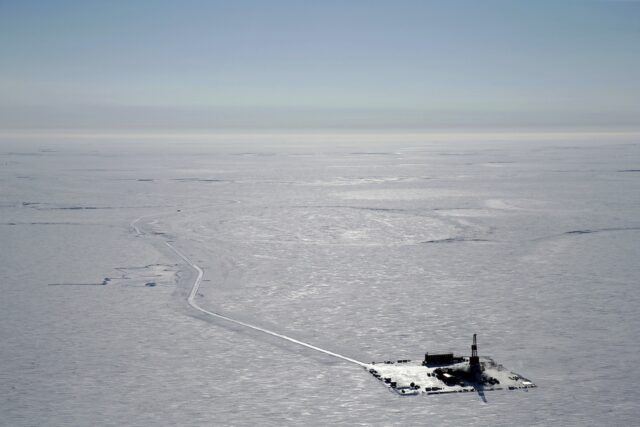As President Joe Biden prepares a final decision on the huge Willow oil project in Alaska, his administration says he will prevent or limit oil drilling in 16 million acres in Alaska and the Arctic Ocean
As Biden weighs Willow, he blocks other Alaska oil drillingBy CHRIS MEGERIAN and MATTHEW DALYAssociated PressThe Associated PressWILMINGTON, Del.
WILMINGTON, Del. (AP) — As President Joe Biden prepares a final decision on the huge Willow oil project in Alaska, his administration announced he will prevent or limit oil drilling in 16 million acres in Alaska and the Arctic Ocean.
Plans announced Sunday night will bar drilling in nearly 3 million acres of the Beaufort Sea — closing it off from oil exploration — and limit drilling in more than 13 million acres in a vast swath of land known as the National Petroleum Reserve – Alaska.
The moves come as regulators prepare to announce a final decision on t he $8 billion Willow project, a controversial oil drilling plan pushed by ConocoPhillips in the petroleum reserve. Climate activists have rallied against project, calling it a “carbon bomb” that would be a betrayal of Biden’s campaign pledges to curb new oil and gas drilling.
Meanwhile, Alaska lawmakers, unions and indigenous communities have pressured Biden to approve the project, saying it would bring much-needed jobs and billions of dollars in taxes and mitigation funds to the vast, snow- and ice-covered region nearly 600 miles (965 kilometers) from Anchorage. Sen. Dan Sullivan, R-Alaska, called Willow “one of the biggest, most important resource development projects in our state’s history.”
Biden’s decision on Willow will be one of his most consequential climate decisions and comes as he gears up for a likely reelection bid in 2024. A decision to approve Willow risks alienating young voters who have urged stronger climate action by the White House and flooded social media with demands to stop the Willow project. Approval also could spark protests similar to those against the failed Keystone XL oil pipeline during the Obama administration.
Rejection of the project would meet strong resistance from Alaska’s bipartisan congressional delegation, which met with top officials at the White House in recent days to lobby for the project. Republican Sen. Lisa Murkowski, who provided key support to confirm Interior Secretary Deb Haaland, said it was no secret she has cooperated with the White House on a range of issues.
“Cooperation goes both ways,″ she told reporters.
Haaland, who fought the Willow project as a member of Congress, has the final decision on whether to approve it, although top White House climate officials are likely to be involved, with input from Biden himself. The White House said no final decision on Willow has been reached.
Under the conservation plan announced Sunday, Biden will bar drilling in nearly 3 million acres of the Arctic Ocean, and impose new protections in the petroleum reserve.
The withdrawal of the offshore area ensures that important habitat for whales, seals, polar bears and other wildlife “will be protected in perpetuity from extractive development,” the White House said in a statement.
The action completes protections for the entire Beaufort Sea Planning Area, building upon President Barack Obama’s 2016 withdrawal of the Chukchi Sea Planning Area and the majority of the Beaufort Sea, the White House said.
Separately, the administration moved to protect more than 13 million acres within the petroleum reserve, a 23-million acre chunk of land on Alaska’s North Slope set aside a century ago for future oil production.
The proposed Willow project is within the reserve, and ConocoPhillips has long held leases for the site. About half the reserve is off limits to oil and gas leasing under an Obama-era rule reinstated by the Biden administration last year.
Areas to be protected include the Teshekpuk Lake, Utukok Uplands, Colville River, Kasegaluk Lagoon and Peard Bay Special Areas, collectively known for their globally significant habitat for grizzly and polar bears, caribou and hundreds of thousands of migratory birds.
Abigail Dillen, president of the environmental group Earthjustice, welcomed the new conservation plan, but said if the Biden administration believes it has authority to limit oil development in the petroleum reserve, officials should extend those protections to the Willow site.
“They have the authority to block Willow,” she said in an interview Sunday.
Athan Manuel, director of the Sierra Club’s lands protection program, said the benefits of the new protections would be more than undone by damage from Willow, which would be the biggest new oil field in decades in Alaska, producing up to 180,000 barrels per day, according to ConocoPhillips.
“No proposal poses a bigger threat to lands, wildlife, communities and our climate than ConocoPhillips’ Willow project,” Manuel said in a statement. “Oil and gas leasing on public lands and waters must end — full stop. The eyes of the world are watching to see whether this administration will live up to its climate promises.”
In 2015, President Barack Obama halted exploration in coastal areas of the Beaufort and Chukchi seas, and he later withdrew most other potential Arctic Ocean lease areas — about 98 percent of the Arctic outer continental shelf. The bans were intended to protect polar bears, walruses, ice seals and Alaska Native villages that depend on the animals.
President Donald Trump reversed Obama’s decision, but a federal judge restored the Obama-era restrictions in 2019, ruling that Trump exceeded his authority.
The Biden administration received one bid in December for the right to drill offshore for oil and gas in Alaska’s Cook Inlet.
___
Daly reported from Washington.

COMMENTS
Please let us know if you're having issues with commenting.